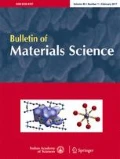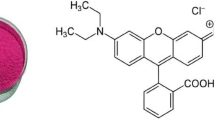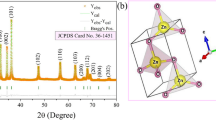Abstract
ZnO-flaky-like nanoflowers with enhanced photocatalytic activity were synthesized by a new hydrothermal technique. The material was characterized and the photocatalytic studies were conducted under solar light irradiation for a model azo dye, Orange G. The material was compared with ZnO nanosphere and nanorod. The results showed the particle size of the nanostructures as a nanorod is 62–81 nm, as a nanosphere is 40–70 nm and as flaky nanoflowers is 20–30 nm (thickness of the flake). The photocatalytic activity showed an enhanced 2-fold increase in the activity for nanoflowers when compared to nanorods and spheres. The Brauner–Emmett–Teller results showed that the nanoflowers (14.197 m2 g−1) had a higher surface area nearly 3.5 times when compared to the nanospheres (4.06 m2 g−1) and seven times with nanorods (2.1 m2 g−1) which is the possibility of such high photocatalytic activity. The smaller particle size and the arrangement of nanoflowers play an important role in enhanced photocatalytic activity.
Graphic abstract
ZnO flaky-nanoflowers as enhanced photocatalyst for the degradation of organics under solar light irradiation. It showed a two-fold increase in activity than ZnO nanospheres and nanorods.










Similar content being viewed by others
References
Rasmi P 2018 IOP Conf. Ser. Earth Environ. Sci. 120 012016
Zorawar S and Pooja C 2016 J. Occup. Med. Toxicol. 39 1
Haibo C, Chen W, Li H, Ma R, Yu Z, Li L et al 2019 J. Environ. Manag. 237 519
Stylidi M, Kondarides D I and Verykios X E 2004 Appl. Catal. B Environ. 47 189
Kezhen Q, Bei C, Yu J and Wingkei H 2017 J. Alloys Compd. 727 792
Suganya Josephine G A, Saranya R and Sivasamy A 2015 J. Saudi Chem. Soc. 19 549
Fujishima A and Honda K 1972 Nature 238 37
Li X, Lu X, Qi H, Yu K and Zhang K 2018 ChemistrySelect 15 5025
Rania A E, Gallia P, Magnus W and Omer N 2018 Photonics Nanostruct. 32 11
Gunja S and Satya Pal S 2020 AIP Conf. Proc. 2220 020184
Ni Y H, Wei X W, Hong J M and Ye Y 2005 Mater. Sci. Eng. 121 4247
Lin C S, Hwang C C, Lee W H and Tong W Y 2007 Mater. Sci. Eng. B 140 31
Yang L Y, Dong S Y, Sun J H, Feng J L, Wu Q H and Sun S P 2010 J. Hazard. Mater. 179 438
Ma H, Ma W, Chen J F, Liu X Y, Peng Y Y, Yang Z Y et al 2018 J. Am. Chem. Soc. 140 5272
Chatterjee S, Bhanja P, Ghosh D, Kumar P, Kanti Das S, Dalapati S et al 2021 ChemSusChem 14 408
Tam K H, Djurisic A B, Chan C M B, Xi Y Y, Tse C W, Leung Y H et al 2008 Thin Solid Films 516 6167
Thanakorn W, Narongchai O C and Sorapong P 2013 Energy Procedia 34 801
Vijayakumar B W, Shivaraj C, Manjunatha B, Abhishek G, Nagaraju P K and Panda 2020 Sens. Int. 1 100018
Lee K M, Lai C W, Ngai K S and Juan J C 2016 Water Res. 88 428
Madathil, Aneesh N P, Vanaja K A and Jayaraj M K 2007 Int. Soc. Opt. Photon. 6639 66390
Cao Z, Wang Y and Li Z 2016 Nanoscale Res. Lett. 11 34
Suganya Josephine G A, Jayaprakash K, Suresh M and Sivasamy A 2019 Mater. Today Proc. 17 345
Meenakshi G, Sivasamy A, Suganya Josephine G A and Kavitha S 2016 J. Mol. Catal. A Chem. 411 167
Meetani M A, Rauf M A, Hisaindee S, Khaleel A, Al Zamly A and Ahmad A 2011 RSC Adv. 1 490
Acknowledgements
We would like to thank the Director Research and Principal AVIT-VMRF, for providing seed grant for conducting the work. We would also like to thank the Director CLRI, for the infrastructure.
Author information
Authors and Affiliations
Corresponding author
Supplementary Information
Below is the link to the electronic supplementary material.
Rights and permissions
About this article
Cite this article
Suganya Josephine, G.A., Jayaprakash, K., Meenakshi, G. et al. Photocatalytically active ZnO flaky nanoflowers for environmental remediation under solar light irradiation: effect of morphology on photocatalytic activity. Bull Mater Sci 44, 247 (2021). https://doi.org/10.1007/s12034-021-02531-1
Received:
Accepted:
Published:
DOI: https://doi.org/10.1007/s12034-021-02531-1




